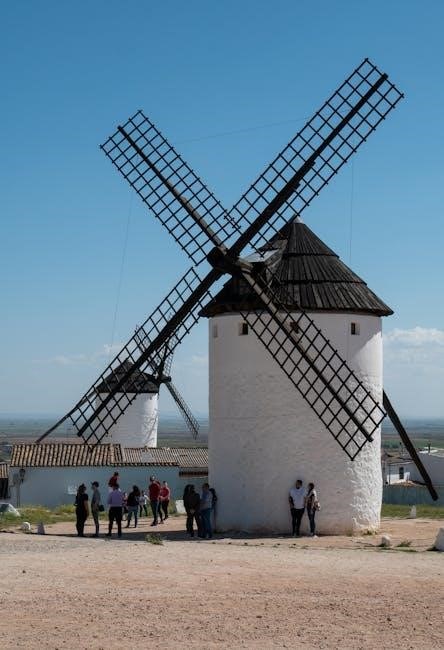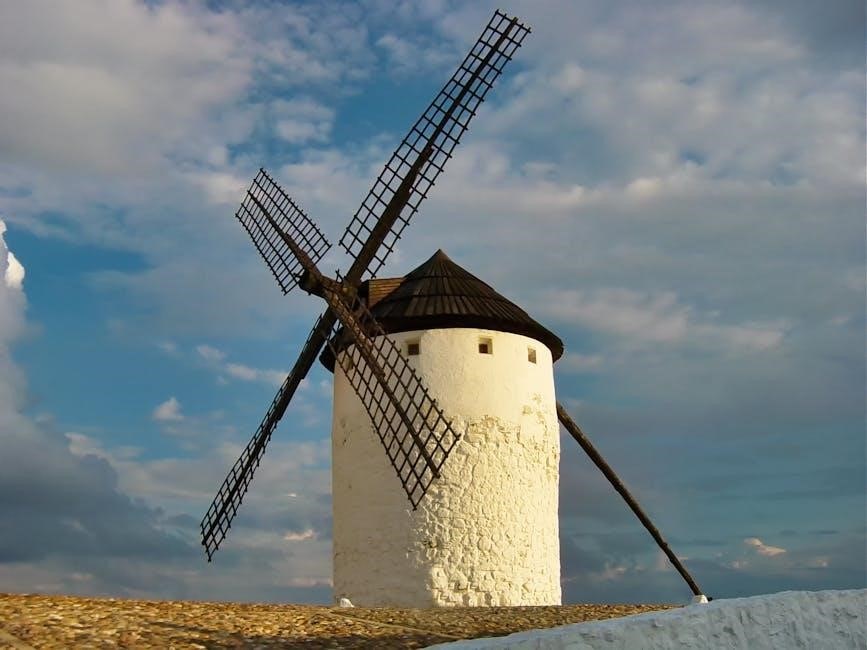
Historical Background of “Don Quixote”
Written in the early 17th century, “Don Quixote” reflects the societal shifts of Spain during its decline from a golden age empire.
1.1 The Life and Times of Miguel de Cervantes
Miguel de Cervantes, the renowned Spanish novelist, playwright, and poet, was born in 1547 in Alcalá de Henares. His life was marked by turmoil, including years as a naval soldier, captivity in Algeria, and financial struggles. These experiences deeply influenced his writing, culminating in “Don Quixote,” a masterpiece that blends humor, philosophy, and a critique of chivalric romances.
1.2 The Context of 17th-Century Spain
17th-century Spain was marked by the decline of its empire, economic stagnation, and social upheaval. The once-mighty Spanish Empire faced financial crises, while the rise of the middle class and the influence of the Catholic Church shaped society. This backdrop inspired Cervantes to critique chivalric ideals and explore themes of reality vs. illusion, reflecting the era’s shifting values and cultural transformations.
The Plot Summary of “Don Quixote”
2.1 The Adventures of Don Quixote and Sancho Panza
Don Quixote and Sancho Panza embark on a series of whimsical adventures, blending humor and tragedy. From attacking windmills to encountering traveling armies, their journeys highlight the knight’s delusional chivalry and Sancho’s pragmatic loyalty. Their contrasting personalities create a rich tapestry of interactions, showcasing the absurdity of Don Quixote’s quest and the enduring bond between master and squire.
2.2 Key Themes and Motifs in the Novel
The novel explores themes of reality vs. illusion, chivalry, and the human condition. Don Quixote’s quest symbolizes the clash between idealism and pragmatism. Satire critiques societal norms, while the bond between Don Quixote and Sancho Panza highlights loyalty and contrasting worldviews. These motifs weave a complex narrative, reflecting the decline of Spain’s Golden Age and the enduring search for meaning in a changing world.
Main Characters and Their Significance
Don Quixote, a nobleman turned mad, embodies idealism and delusion. Sancho Panza, his practical squire, represents realism. Their contrasting perspectives drive the novel’s exploration of human complexity and societal norms.
3.1 Don Quixote: The Idealistic Knight
Don Quixote, a nobleman obsessed with chivalric romances, embodies the clash between idealism and reality. His delusional perception of the world, driven by a desire to revive knighthood, leads to humorous yet poignant adventures. Despite his madness, his unwavering commitment to honor and justice makes him a tragic yet admirable figure, highlighting the tension between illusion and truth in human existence.
3.2 Sancho Panza: The Pragmatic Squire
Sancho Panza, Don Quixote’s loyal squire, represents practicality and common sense. Unlike his idealistic master, Sancho is grounded in reality, often providing comic relief with his witty remarks and earthly concerns. His simple wisdom and unwavering loyalty create a dynamic contrast, making him an essential counterbalance to Don Quixote’s fantasies and a relatable figure for readers seeking realism amidst the knight’s delusions.

Themes and Symbolism in “Don Quixote”
The novel explores the clash between reality and illusion, delving into themes of chivalry, madness, and the human condition, rich in symbolism that transcends time.
4.1 The Quest for Chivalry and Honor
Don Quixote’s quest embodies the fading ideals of chivalry, as he seeks honor and glory in a world that no longer values such outdated virtues. His journey reflects the tension between romanticized notions of knightly honor and the harsh realities of 17th-century Spain. This quest becomes both a parody of traditional chivalric tales and a profound commentary on the human desire for meaning and purpose. Through his delusions, Cervantes critiques the romanticized past while exploring the complexities of honor in a changing society. The character’s unwavering dedication to his perceived duty highlights the enduring allure of chivalric ideals, even as they become increasingly irrelevant. This duality makes Don Quixote a timeless figure, suspended between reality and illusion, seeking honor in a world that no longer understands it. His quest, ultimately, is a poignant reflection on the human condition, blending humor with philosophical depth. The novel’s exploration of chivalry and honor continues to resonate, offering insights into the nature of identity and purpose. By examining Don Quixote’s motivations and the societal context, readers gain a deeper understanding of the themes that make this work a cornerstone of world literature.
4.2 The Struggle Between Reality and Illusion
Don Quixote’s perception of the world is deeply entangled with illusion, shaped by his obsession with chivalric romances. He transforms windmills into giants and inns into castles, embodying the clash between fantasy and reality. This struggle reflects the human tendency to seek meaning and escape through imagination, even when it distorts truth. Sancho Panza’s pragmatism contrasts with Don Quixote’s delusions, highlighting the tension between idealism and practicality. The novel explores how reality is shaped by individual perceptions, raising questions about the nature of truth and imagination. This timeless theme resonates with readers, inviting reflection on the boundaries between illusion and reality in their own lives. The interplay between Don Quixote’s fantasies and the real world creates a rich tapestry of philosophical and comedic elements, making the novel a profound exploration of human cognition and experience. Through this struggle, Cervantes critiques societal norms while celebrating the enduring power of imagination. The character’s journey ultimately invites readers to ponder the role of illusion in shaping their own realities. This duality of perception remains a central theme, offering insights into the human condition. The novel’s exploration of reality and illusion continues to captivate audiences, ensuring its relevance in modern times. By examining Don Quixote’s delusions, readers gain a deeper understanding of the interplay between imagination and reality. The struggle between the two becomes a metaphor for the human experience, blending humor with profound philosophical inquiry. This theme is central to the novel’s enduring legacy, making it a timeless classic of world literature. The balance between illusion and reality is a recurring motif, enriching the narrative with depth and complexity. Don Quixote’s quest, driven by illusion, ultimately reveals the power of imagination to shape human understanding. The novel’s exploration of this struggle remains unparalleled, offering timeless insights into the human condition. Through Don Quixote’s journey, readers are reminded of the enduring power of imagination, even in the face of reality. The interplay between illusion and reality continues to resonate, making the novel a cornerstone of literary study. The struggle between the two is a testament to the complexity of human perception, as explored in “Don Quixote.” This theme ensures the novel’s relevance, inviting readers to reflect on their own relationship with reality and illusion. The tension between the two is a recurring motif, enriching the narrative with philosophical depth. Don Quixote’s delusions serve as a mirror to the human experience, highlighting the enduring power of imagination. The novel’s exploration of reality and illusion remains a central theme, offering insights into the nature of perception. Through Don Quixote’s journey, readers are reminded of the interplay between imagination and reality, a timeless aspect of human existence. The struggle between illusion and reality is a profound commentary on the human condition, ensuring the novel’s enduring appeal. The interplay between the two is a testament to the complexity of human perception, as captured in “Don Quixote.” This theme continues to resonate, making the novel a vital work of literature. The balance between illusion and reality is a recurring motif, enriching the narrative with depth and complexity. Don Quixote’s quest, driven by illusion, ultimately reveals the power of imagination to shape human understanding. The novel’s exploration of this struggle remains unparalleled, offering timeless insights into the human condition. is not allowed, since the response must be exactly .
The Influence of “Don Quixote” on Literature
“Don Quixote” revolutionized literature, inspiring countless writers and shaping modern fiction. Its innovative narrative style and universal themes made it a foundational text for world literature.
5.1 The Birth of the Modern Novel
Miguel de Cervantes’ “Don Quixote” is often regarded as the first modern novel, breaking away from traditional romance narratives. Its realist approach, complex characters, and narrative depth influenced the development of the novel as a literary genre. By exploring human nature and societal realities, it set a new standard for storytelling, impacting authors across centuries.
5.2 Impact on World Literature and Culture
“Don Quixote” has profoundly shaped world literature, inspiring writers like Dickens and Dostoevsky. Its themes of reality vs. imagination resonate globally, influencing art, film, and philosophy. The novel’s cultural impact extends beyond literature, embedding itself in everyday language and symbols, making it a timeless classic that continues to captivate audiences and inspire creative works across diverse mediums and generations.
Accessing “Don Quixote” in PDF Format
The complete eBook of “Don Quixote” is widely available in PDF format, offering readers a convenient way to explore Cervantes’ timeless masterpiece digitally for free.
6.1 Sources for Downloading the PDF
“Don Quixote” in PDF format is easily accessible through various online platforms. Reputable sources include Google Books, Project Gutenberg, and ManyBooks, offering free downloads. Additionally, websites like Archive.org provide the full text for easy access. The eBook is also available on academic databases and literary websites, ensuring readers can conveniently download and enjoy Cervantes’ masterpiece in digital form.
6.2 Benefits of Reading in Digital Format
Reading “Don Quixote” in PDF format offers numerous advantages. It allows for easy portability, adjustable font sizes, and quick navigation. Digital versions enable keyword searches, annotations, and access to additional resources. They also save physical space and reduce eye strain with customizable brightness settings. This modern convenience enhances the reading experience while preserving the timeless appeal of Cervantes’ masterpiece.

The Complete eBook: “The Complete Don Quixote”
The complete eBook of “Don Quixote” offers the full, unabridged text of Cervantes’ masterpiece, ensuring an immersive reading experience with all volumes and chapters included digitally.
7.1 Overview of the Full Text
The full text of “Don Quixote” spans two parts, published in 1605 and 1615. It narrates the adventures of the nobleman Alonso Quixano, who becomes Don Quixote, and his squire Sancho Panza. The novel explores themes of chivalry, reality, and madness, blending humor and philosophy. The complete eBook version includes all chapters, preserving Cervantes’ original storytelling and linguistic richness, offering readers a comprehensive and authentic experience of this literary masterpiece.
7.2 Additional Resources and Supplements
Supplementary materials include study guides, scholarly commentaries, and multimedia resources. These enhance understanding of “Don Quixote” through historical context, character analysis, and thematic insights. Audio dramatizations and interactive timelines further enrich the reading experience, offering deeper engagement with Cervantes’ masterpiece for both casual readers and academics alike.

The Significance of “Don Quixote” in Modern Times
Don Quixote’s themes of reality vs. imagination, perseverance, and the human spirit remain timeless, inspiring modern readers to reflect on life’s complexities and pursue their ideals.
8.1 Relevance of Its Themes Today
Themes such as the struggle between reality and illusion resonate deeply in today’s world, where social media often blurs the lines between authenticity and fantasy. The novel’s exploration of mental health, societal expectations, and the pursuit of identity continues to strike a chord with modern audiences, making it a timeless commentary on human nature and contemporary challenges. Additionally, the PDF format allows easy access to these themes, enabling readers to engage with the text in a convenient and portable manner, fostering a deeper understanding of its relevance in the digital age. The availability of “Don Quixote” in PDF ensures that its universal messages reach a broader audience, maintaining its significance across generations and technological advancements.
8.2 Adaptations and Interpretations
“Don Quixote” has inspired countless adaptations, including films, stage productions, and artworks, each offering unique interpretations of its themes. The novel’s timeless appeal allows it to be reimagined across cultures and mediums. Its themes of chivalry, illusion, and reality continue to captivate audiences, ensuring its relevance in modern storytelling. The availability of the novel in PDF format further enhances its accessibility, enabling readers to explore its enduring influence across generations and artistic expressions. This versatility underscores its lasting impact on global culture and literature. Additionally, the digital format allows for easier sharing and interpretation, introducing the classic tale to new audiences worldwide. The PDF version remains a popular choice for scholars and enthusiasts alike, facilitating deeper analysis and appreciation of Cervantes’ masterpiece. By embracing technology, “Don Quixote” continues to evolve, ensuring its place in the modern literary landscape. Its adaptability and universal themes guarantee that it will remain a cherished and influential work for years to come.

The Art of Reading “Don Quixote” Digitally
Reading “Don Quixote” in PDF offers enhanced accessibility and convenience, allowing customization of fonts and night mode for comfort, while annotations and bookmarks aid deeper engagement with the text.
9.1 Tips for Navigating the PDF
Use bookmarks to mark key chapters and sections. Employ the search function to quickly locate specific phrases or names. Thumbnails can help navigate visually. Adjust zoom levels for readability. Utilize hyperlinks if available for references or notes. Keyboard shortcuts like “Ctrl + F” simplify searches. Familiarize yourself with the table of contents for easy access. These features enhance navigation and improve the reading experience.
9.2 Enhancing the Reading Experience
Adjust font sizes and brightness for optimal readability. Use night mode to reduce eye strain during evening reads. Enable annotations to highlight key passages and take notes. Customize the layout to suit your screen size. Utilize two-page viewing for a book-like experience. Experiment with different fonts for comfort. These adjustments create a personalized and immersive reading environment for “Don Quixote” in PDF format.
The Legacy of “Don Quixote” in Academic Studies
Scholars worldwide analyze “Don Quixote” as a foundational text, exploring its themes, literary innovation, and cultural impact, solidifying its place in academic curricula and literary theory.
10.1 Scholarly Analysis and Criticism
Scholars widely regard “Don Quixote” as a foundational text in literary studies, analyzing its narrative structure, themes of reality vs. imagination, and the complexity of its protagonist. Academic criticism often explores its influence on the development of the novel as a genre and its enduring relevance in postmodern and psychoanalytic interpretations, making it a cornerstone of literary theory and academic discourse.
10.2 Its Place in Literary Curricula
“Don Quixote” is a staple in academic syllabi worldwide, taught for its rich themes, narrative innovation, and historical significance. Its inclusion in curricula highlights its role in shaping modern literature, offering insights into the evolution of storytelling and cultural contexts, making it essential for students of literature, history, and cultural studies to engage with this seminal work.

The Timeless Appeal of “Don Quixote”

The Role of “Don Quixote” in Popular Culture
“Don Quixote” has profoundly influenced music, film, and media, with its iconic imagery and themes appearing in countless adaptations and references, solidifying its cultural impact.